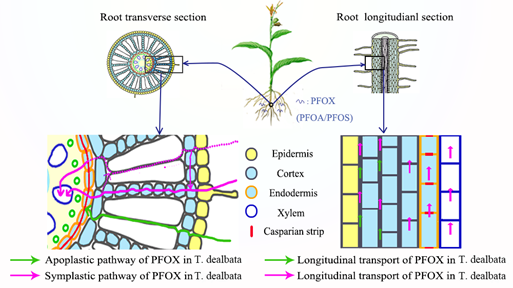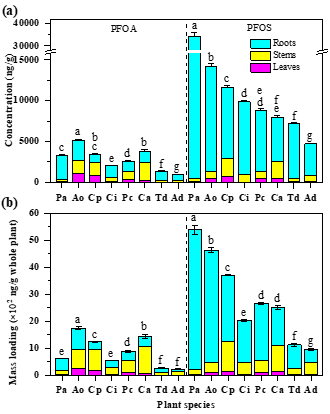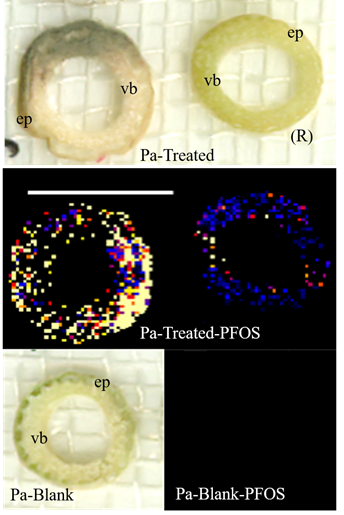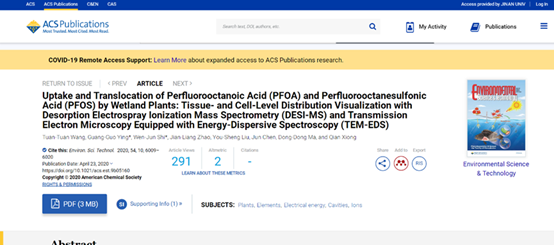Wang et al. found that the uptake of PFOS and PFOA in plant roots was via symplastic route and apoplastic route
Tuan-Tuan Wang, a joint PhD student of Professor Guang-Guo Ying at SCNU Environmental Research Institute (SERI) and Guangzhou Institute of Geochemistry, Chinese Academy of Sciences, recently published a research article titled “Uptake and translocation of perfluorooctanoic acid (PFOA) and perfluorooctane sulfonic acid (PFOS) by wetland plants: Tissue- and cell-level distribution visualization with desorption electrospray ionization mass spectrometry (DESI-MS) and transmission electron microscopy equipped with energy-dispersive spectroscopy (TEM-EDS)” in Environmental Science & Technology.

Perfluoroalkyl substances (PFASs) are a class of human made surfactants that have been widely used in industrial and commercial applications. Perfluorooctanoic acid (PFOA) and perfluorooctane sulfonic acid (PFOS) are the most representative PFASs chemicals due to their high concentrations and detection frequencies. Due to their wide detection, environmental persistence, high bioaccumulation, and potential effects, PFASs have aroused great concern among the scientific community and the general public. Phytoremediation, especially root tissue-enhanced processes, including uptake and transmission, are expected to contribute to aqueous removal of PFASs. However, the uptake, accumulation, transmission, and tissue- and cell-level distribution of PFOA and PFOS in wetland plants are still unclear.

Wang et al. investigated the uptake and translocation of perfluorooctanoic acid (PFOA) and perfluorooctane sulfonic acid (PFOS) in eight common wetland plants and visualized their tissue- and cell-level distribution with desorption electrospray ionization mass spectrometry (DESI-MS) and transmission electron microscopy equipped with energy-dispersive spectroscopy (TEM-EDS).

The results showed that the PFASs accumulated in plants accounted for 1.67−16.7% of the total mass spiked into the hydroponic systems, and PFOS accumulated largely in roots (48.8−95.8%), while PFOA was stored mostly in the aboveground part (29.3−77.4%). DESI-MS and TEM-EDS results showed that PFOS and PFOA were found in the root epidermal cells, cortex, and vascular bundles in plants Canna indica (Ci), Thalia dealbata (Td), Cyperus alternifolius (Ca), Phragmites australis (Pa) and PFOS and PFOA contents decreased consecutively from the epidermal cells to the cortex. PFOS and PFOA contents decreased progressively from the cortex to the vascular bundle in plants Td and Pa, while PFOS and PFOA contents in the vascular cylinder were higher than that in the cortex in plants Ci and Ca. This was attributed to the uptake route of PFOS and PFOA in plants that PFOS and PFOA were transported from the cortex to the vascular bundle via both apoplastic (e.g., across cell walls and/or intercellular spaces) and symplastic routes (e.g., across plasma membranes or via plasmodesmata) in plants Ci and Ca while via only symplastic route in plants Td and Pa. Transport of chemicals in the apoplastic route is much more rapid than transport in the symplastic route. Thus, more PFASs in the cortex could arrive at the vascular bundle of plants Ci and Ca, and high concentrations of PFASs were found in vascular bundle of Ci and Ca, but not in Td and Pa.
The findings from this study provide a new research tool combining DESI-MS and TEM-EDS for investigating bioaccumulation of PFASs and also provide a scientific basis for remediation of PFASs contaminated environment.
The published article is listed as follows:
Wang, T.-T., Ying, G.-G., Shi, W., Zhao, J.-L., Liu, Y.-S., Chen, J., Ma, D.-D., Xiong, Q., 2020. Uptake and translocation of perfluorooctanoic acid (PFOA) and perfluorooctane sulfonic acid (PFOS) by wetland plants: Tissue- and cell-level distribution visualization with desorption electrospray ionization mass spectrometry (DESI-MS) and transmission electron microscopy equipped with energy-dispersive spectroscopy (TEM-EDS). Environmental Science & Technology, 54(10), 6009−6020. https://pubs.acs.org/doi/10.1021/acs.est.9b05160
